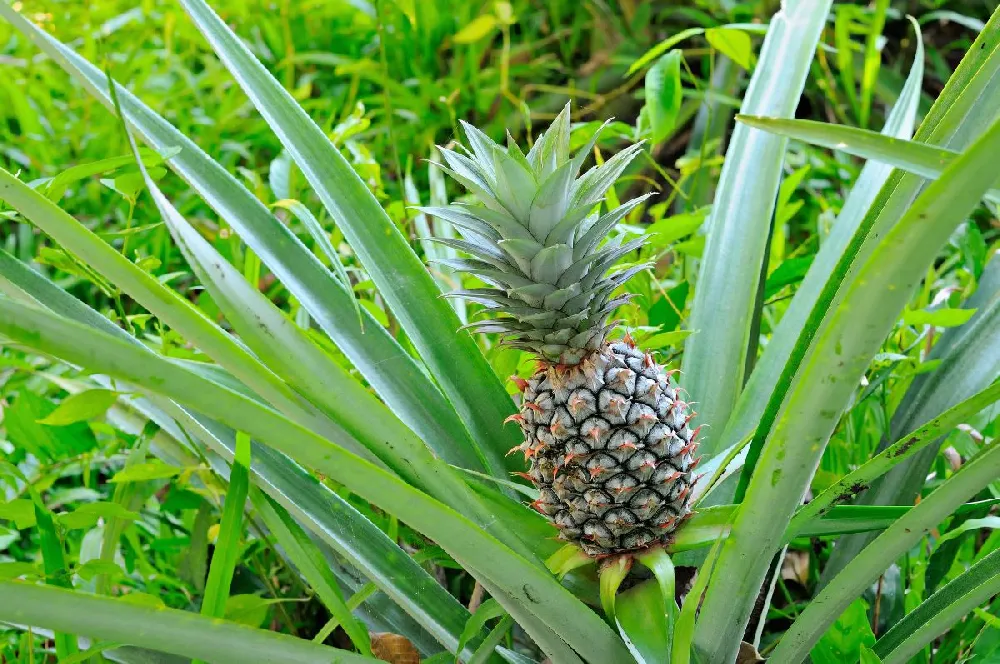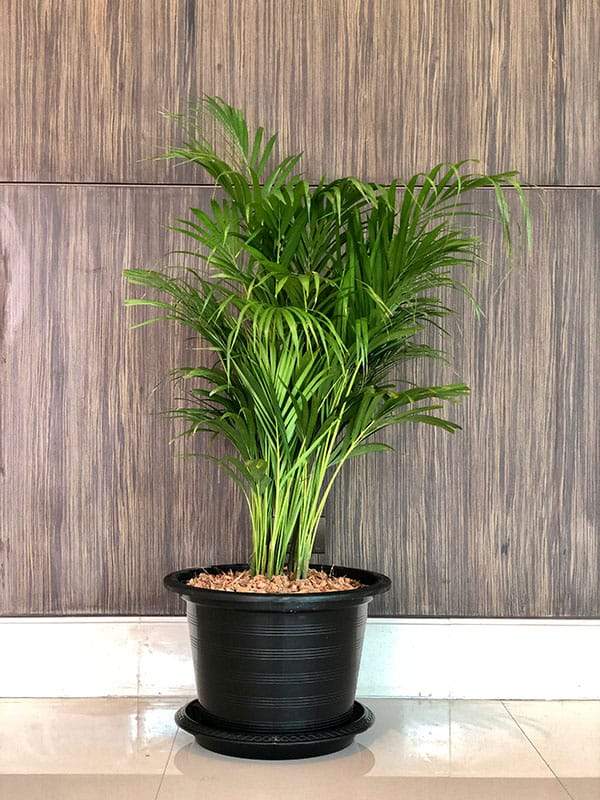- Home >
- Jade Plants
Jade Plants for Sale - Buying & Growing Guide
2 Results
Planting and Care
Planting instructions
Jade plants can be planted indoors in most areas, or outdoors in USDA Hardiness Zones 10 and above. In colder climates, it’s typically grown as a houseplant. If growing outside in a desert landscape, plant 12 to 18 inches apart, depending on the desired size of the plants. Dig a hole about twice as large as the root ball and insert the jade plant level with the ground, backfilling with soil. If growing indoors, consider that the jade plant may become top heavy, so you should opt for a short and wide pot to handle the weight.
Watering and nutrients
After planting, wait to water your jade plant for a few days. This allows the roots to acclimate to their new home and recover from the transition. Once the plant establishes itself, watering schedules will change with the seasons. When the plant is growing in the spring and summer, jade requires thorough watering whenever the soil dries out. Wet the soil entirely and allow the first few inches of soil, rather than the entire rootball, to dry before watering again. In the dormant seasons of fall and winter, it only requires water every month or two.
Jade plants should be fertilized about twice per year. Use a liquid fertilizer suitable for house plants. If your jade plant is in a dormant period, it will not need fertilizer until it begins to grow again.
Pruning
You can prune your jade plant as you please for aesthetics. As you prune the top branches, the bottom stems will grow bigger and thicker, leading to the woody appearance of more mature jade plants. Some people enjoy using jade plants as a learning platform for the art of bonsai. With some delicate pruning work, a jade plant can be crafted to resemble larger trees.
Pests and diseases
Crassula ovata is susceptible to a few pests. Scale insects, minuscule, barely visible pests, weaken a jade plant and cause deformation. This can be remedied using a cotton swab and isopropyl alcohol. Soak the cotton in alcohol before applying it to the plant to kill the insects. Repeat this process for a few days until the infestation has been eliminated. Spider mites and aphids are less common, but you may find them on your jade plants. Neem oil is a natural remedy that can deter these pests.
Temperature
Jade plants like the dry season very much. The best daytime temperature for them is 65-75 F. (18-24 C). Cold weather and damp weather are not good for Jade. It loses its color and turns yellow and mushy. But they can tolerate drought and can survive cold nights if they get a lot of sunlight the next day.
Light
Lighting is important to any plant. Succulents like the light very much but do not need as much. Some succulents, such as Tiger Fern, can survive without sunlight for a long time.
Jade plants can grow under full sun, but you can place Jade plant near a window, and it will do fine. Try to keep the Kade plant around 2 ft from a window. Jade plants also might not do well under the scorching sun, so check if your plant is receiving intense sunlight. If it looks yellowish or leggy, try placing it somewhere else or increase your watering routine.
Soil
You can your regular potting soil mixture if it doesn’t hold too much moisture. Like any other succulent, the soil mixture for Jade plants needs aerating and proper draining. Add coconut coir and Pine bark to make the soil more drainage friendly.
Humidity
Low humidity is best for Jade plants. 30 to 50% humidity is perfect. Place the Jade plant either outside on the balcony or on the deck or by an open indoor window to keep the air around it circulating.
Propagation
It is very easy to propagate Jade plant. You take a root cutting or stem and leaf cuttings.
You can also take the leaves that get mushy from overwatering. You can save that leaf and grow another Jade plant. Cut the leaf a few inches above the mushiness and set it aside until it dries out.
Leave the dried up cutting over some soil, and water it once or twice depending on the soil. Roots will begin to grow out of the leaf in about four weeks as long as it has a proper environment.
You will see little Jade plants as soon as the roots take hold.
Repotting
You have to be careful when repotting Jade plants. You cannot just re-plant a jade plant from a small pot to a larger pot. Jade plant does not mind being in a small pot or root-bound. When you buy a new Jade plant, you should wait until it outgrows it existing pot before you transfer it.
Accidents often happen when repotting, so be careful.
Follow these steps.
1. Mix your soil for the new pot thoroughly. Hold the Jade plant at the base and gently tip the pot down. Tap the bottom and remove the plant with the soil. Brush off the excess soil from the plant with your hand. Check if there is any damage.
2. Check for white roots, which are healthy. Dark, black, or brown and damp roots are not good.
3. Put 1 inch of gravel at the bottom of the pot and then add a third of the new soil mixture and your plant Cover the rest of the plant with soil.
4. Water the plant to set the soil mixture. Make sure it drains well.
Common Problems & Pests
Jade plants are a beautiful addition to any home, and you can even create your own little garden indoors without investing a lot of money. But everything has its dark side, and Jade can be the reason for some problems. Here are some solutions for common problems.
Toxic for human and pets
Jade plant has a slight toxicity for human and pets. It will not cause death or serious illness, but can cause nausea.
We advise you to keep children and pets away so that they do not consume Jade plant leaves.
Yellow leaves
Sometimes, you will see e leaves turning yellow. This can happen from overwatering or underwatering your Jade plant.
If you notice that some leaves are rotting, that is a clear sign that you are overwatering your plant. You have to readjust your watering routine and the amount of water you use.
If, after re-adjusting your watering, you still see yellow leaves, check the roots. You might have to trim dark roots.
If all of the roots are rotten, the best option is to choose the best leaves from the plant and propagate them.
Formation of black or white mold
You might see black mold growing on the leaves of the Jade plant. Too much humidity in the air can cause this problem. You can solve it by wiping off the mold with soapy water. Also try to move the plant to a place where air circulation is better and there is less humidity.
Your Jade plant might also develop white mold in the soil. Overwatering or too much fertilizer can cause this problem. Again, remove the mold and re-adjust your watering routine and adjust the watering level.
Jade Plant Varieties
The Jade plant, or Crassula ovata, has curved and oval-shaped leaves that usually grow upwards and spread out. But that is only one type of Jade plant we commonly know. There are more than 1,400 varieties of Jade plant. Some types are very rare, and they come at a high price. Jade plants with different features are given different names. Some are very lovely, such as the lucky plant, dwarf jade, true jade, Hobbit, Gollum, etc.
Sunset
One of the most popular Jade plants is Sunset, also known as Hummel’s Sunset. Its yellowish leaves with red tips look amazing, and it grows very well. It’s a great choice for a rock garden or as indoor decoration.
Monstruosa
Monstruosa is categorized as Monstruosa Hobbit, and Monstruosa Gollum, whose name are from the characters of Lord of the Rings movie. You can distinguish the two of them by looking at their leaves. Hobbies have a curled leaves while Gollum’s leaves are almost tubular with their reddish tint. Hobbits are shrubbier and smaller in size than Gollums when reaching ther maximum height.
Blue bird
Blue Bird is one of most beautiful succulents. People adore it as a balcony plant. Blue Bird (or Crassula arborescens or Silver Jade Plant) has gorgeous gray or blue-ish foliage with purple/pink tips. Silver Jade can grow very wide. There are some varieties of Blue Bird as well.
Crassula campfire
Crassula Campfire, or Crassula capitella, has propeller-like leaves. They have a light green and bright red color. Campfire grows a white flower in the summer. They provide a dramatic look to the environment,
Crassula capitella
Crassula capitella, also known as Red Pagoda, is a gorgeous looking plant that can instantly brighten up a room. When the plant is small, it looks like a pink-tinged rosette, and then later, it forms the shape of the pagoda, and the color brightens into red.
Crassula rupestris (Baby’s Necklace)
Perhaps one of the best-looking crassula hybrids is Baby’s Necklace. It’s an odd name, but it will absolutely wow everyone. This Jade plant has small rounded green-gray and reddish leaves. It looks like a beaded necklace and makes another great choice for your decorations.
Ripple leaf
Ripple Leaf Jade is another hybrid. It has thin leaves and undulated edges. Its a rather strange, not very common type of plant. It grows well under the sun, but you can also keep it indoors with access to indirect light. It’s called Ripple Leaf because of the rippled leaf edges.
There many other Jade plant varieties and hybrids that you can explore.
FAQs
Why are my jade plant’s leaves falling off?
What do jade plants symbolize?
Jade plants have been associated with some superstitions, such as the belief that they can attract wealth. This is probably because they resemble jade stones, which have long been a symbol of the rich and prosperous. Jade plants are also believed to emanate “qi”, a positive life force and energy that is revered in traditional Chinese medicine.
Are jade plants poisonous?
Jade plants are toxic to dogs and cats, so make sure to plant them in places where your pets can’t nibble. If you’re in a farm setting, you should also be wary of your horses finding their way to your jade plants, as they will also exhibit toxic reactions. Jade plants have an edible look-alike, Portulacaria afra, which makes toxic mix-ups somewhat common. Be wary, as the plant is mildly toxic to humans, both when it’s ingested or touched.



